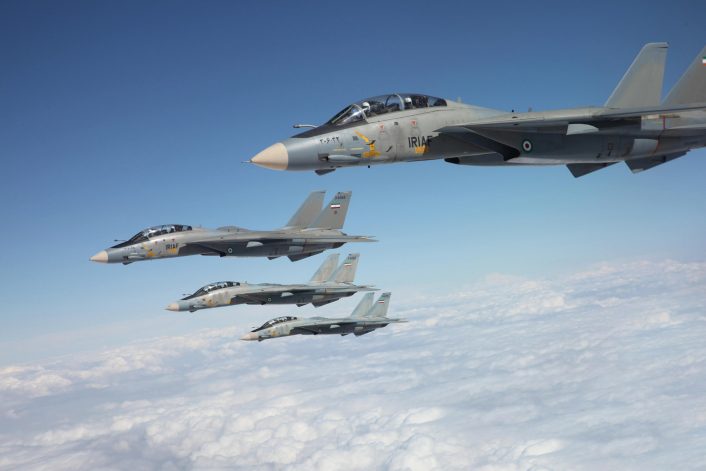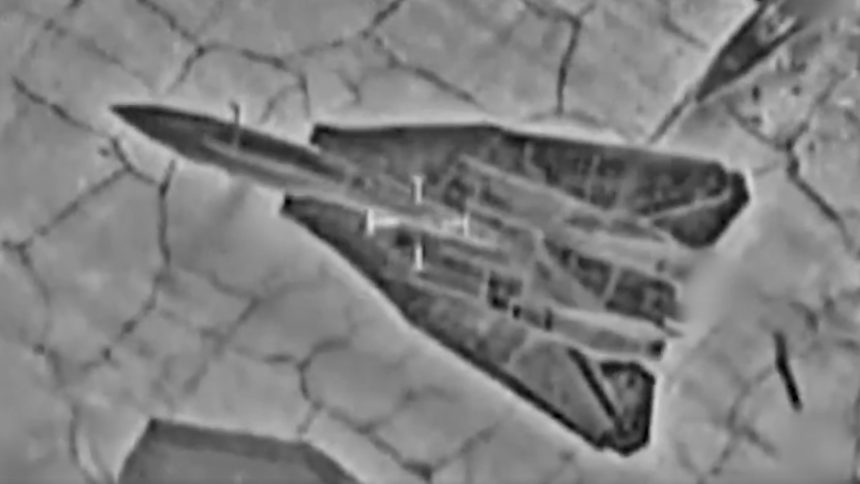The Israeli Air Force has just released footage showing the destruction of two F-14 Tomcats (likely non-operational) on the ground.
The Israel Defense Forces (IDF) have released footage showing precision drone strikes on two Iranian F-14 Tomcat fighter jets stationed at an airbase near Tehran. of those appears to be not operational (at least based on the state of one of the two tails). The strike, part of what the IDF described as a wider preemptive operation, was confirmed by IDF Spokesperson Brig. Gen. Effie Defrin during a press briefing.
An Israeli Air Force drone struck and destroyed two Iranian F-14 fighter jets at an airport in Tehran, IDF Spokesman Brig. Gen. Effie Defrin reveals in a press conference.
The IDF publishes footage of the strike.
Additionally, the IDF airs footage of a strike on Iranian… pic.twitter.com/z6QwK8brBH
— Emanuel (Mannie) Fabian (@manniefabian) June 16, 2025
The video, released by the IDF, shows the moment the drones hit the aircraft on the ground, destroying both airframes. The F-14, a long-retired type in the U.S. Navy, remains (or remained…) in limited service with the Islamic Republic of Iran Air Force (IRIAF). Although the two airframes were likely non-operational and had been visible in satellite imagery for years), the strike is particularly symbolic. The Persian Tomcats, the world’s last operational F-14s, had long been considered a symbol of Iran’s ability to keep the type airworthy and even upgrade it despite the embargo.
It appears that both Iranian F-14 Tomcats were in non-operational state. https://t.co/agD9lrgW4g pic.twitter.com/HaNd84MmuH
— Clash Report (@clashreport) June 16, 2025
In the previous days, among the targets hit in Tehran was Mehrabad Airport, which might be the one in the videos. In fact, while the airport is known to host MiG-29s and Su-24s, according to some reports, it might also host some of the Iranian F-14s.
In addition to the F-14 footage, the IDF published several other videos from the same operation. One clip shows an airstrike on Iranian forces allegedly preparing to launch drones toward Israel. Another video captures a precision strike on containers identified by the IDF as housing unmanned aerial vehicles.
The IDF also shared footage of a strike on Iran’s state media facility in Tehran, which Israeli officials said was involved in disseminating propaganda and supporting hostile operations against Israel.
The videos were released as part of a broader campaign to demonstrate the reach and effectiveness of Israeli intelligence and long-range strike capabilities. While details about the platform used in the attacks were not disclosed, the operation appears to highlight the IAF’s ability to conduct deep strikes with precision and minimal collateral damage.
The world’s last operational F-14s
The Persian Tomcats are the world’s last operational F-14s, after the main user, the U.S. Navy, retired the type in 2006.
Iran initially ordered 80 examples for the Imperial Iranian Air Force, with 79 being delivered beginning in February 1976. This was before the Shah of Iran was deposed from power in 1979, giving birth to the Islamic Republic of Iran and the aircraft passing in the hands of the current Islamic Republic of Iran Air Force (IRIAF).
According to different sources, Iran has currently around 40 – 42 airframes at its disposal, some of those upgraded to F-14AM (“Modernized”) standard that includes domestic avionics (radar and RWR) and weapons: R-73E, AIM-54A, AIM-7E and AIM-9J. Iraan also says it has integrated local weapons on the Tomcat, such as the Fakour-90 air-to-air missile based on the AIM-54 Phoenix and the MIM-23 Hawk.

The IRIAF has two types of F-14As: PMC (Partially Mission-Capable) ones, usually suitable for training and which can become FMC in case of war, and Fully Mission-Capable Tomcats with fully operable fire control system, armament system and INS. These FMC F-14As are usually used for 24/7 Quick Reaction Alert and other combat missions. It was previously reported that usually 70% of the airworthy Tomcats are FMC.
In 2018, during Iran International Air Show at Kish Island, Iran, around two dozen F-14s were estimated to be fully ready for combat, with partial readiness maintained for 16 more airframes. Similarly, a survey by Flight Global estimated that, as of 2019, the IRIAF operated 24 F-14s. These aircraft are based at TFB.8 (Tactical Fighter Base 8) Baba’i near Eshahan, in central Iran.
As notable sightings, in 2015, Iranian F-14 Tomcat escorted Russian Air Force Tu-95 Bear bombers flying in Iranian airspace during their 9h 30mins missions from Engels airbase and back, along the Iraq-Iran-Caspian Sea 6,500 km-long corridor, against targets in Syria. More recently, in December 2023, during Russian President Putin’s trip to the Middle East, one IRIAF F-14 joined the escort of four Su-35S Flankers, armed with R-77 and R-73 air-to-air missiles, of the presidential Il-96-300PU.
Actually this is Iran’s F-14AM Tomcat prototype-3-6049 with some upgrades and the unique desert splinter scheme. The goal was to increase the number of FMC F-14As with fully operational fire control systems and radars. The Tomcat was upgraded over a period of 4 years. 🇮🇷 https://t.co/KQOYZ045ci pic.twitter.com/O5oqnW73oi
— SK79 (@StefanKnippsch3) December 6, 2023
Nowadays, the Islamic Republic of Iran Air Force (IRIAF) remains the world’s only operator of the Tomcat, a type of interceptor that Tehran has been able to kept airworthy and somehow enhance with some domestic avionics upgrades and weapons throughout the years in spite of the embargo imposed after the 1979 Revolution.
It can be safe to assume that the F-14s might be flown under severe constraints to avoid wearing out the old airframes and components. In fact, even if Iran reverse engineered the US-made components needed for the maintenance, experts believe these might not always perform to standards, owing to deficiencies arising from the lack of know-how and the complete design blueprints.
Because of that, Iran also resourced components through smuggling, which delivered some results for a significant amount of time but was not always successful.









